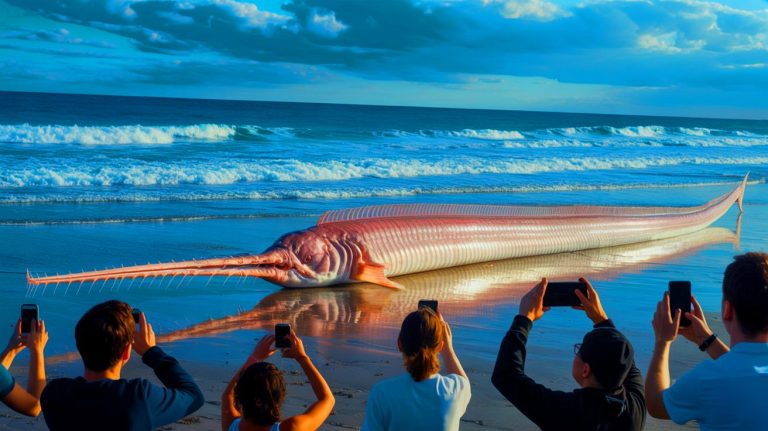| IN A NUTSHELL |
|
The mysterious appearances of the oarfish on the shores of Tasmania and New Zealand have reignited discussions about their elusive nature and the myths surrounding them. Often called the “fish of the apocalypse,” these deep-sea creatures capture the imagination with their striking looks and rare sightings. While these events stir intrigue and speculation, scientists urge a rational perspective, emphasizing the need for empirical understanding over superstition. As we explore the enigmatic world of the oarfish, we delve into the myths, scientific insights, and the captivating journey of a journalist who brings these stories to life.
The Unusual Surge of Oarfish Sightings
The recent surge in oarfish sightings began on Tasmania’s west coast, followed by two more in New Zealand. These creatures, belonging to the Regalecidae family, are known for their elongated bodies that can reach up to 26 feet, making them hard to miss. Andrew Stewart, fish curator at New Zealand’s Te Papa Tongarewa Museum, described them as “magnificent and otherworldly,” highlighting the repetitive nature of their bodies. Despite their fascinating appearance, oarfish sightings remain rare, with only about twenty confirmed cases in New Zealand.
Stewart emphasized the rarity of these occurrences, noting that the museum hoped to secure one specimen for research. Unfortunately, natural predators had already consumed the heads, depriving scientists of valuable data such as otoliths, teeth, and gill rakers. While these events fuel curiosity and speculation, they are isolated incidents rather than common occurrences, underscoring the need for further research and understanding of these deep-sea dwellers.
Debunking Myths Around Oarfish and Natural Disasters
The eerie appearance of oarfish has long fueled myths associating them with natural disasters, particularly earthquakes and tsunamis. In Japan, they are known as ryugu no tsukai, believed to be messengers warning of impending cataclysms. However, scientific studies, including one from 2019, have found no correlation between oarfish appearances and seismic activity. Andrew Stewart advocates for a science-based approach, emphasizing the absence of any proven link between these sightings and natural disasters.
Oarfish live in the deep ocean, primarily in open oceanic areas, making their observation rare and contributing to the mystique surrounding them. Nick Ling, a fish ecologist at the University of Waikato, explains that this scarcity fuels numerous myths. He describes their unique vertical swimming style, where they undulate their dorsal fins, calling them “truly beautiful fish” with an “extraordinary lifestyle.” By understanding their true nature, we can appreciate these creatures without the shadow of superstition.
The Fascination with Abyssal Creatures
Beyond their mythical status, oarfish captivate scientists and the public alike due to their enigmatic existence. These deep-sea residents remain largely a mystery, with much of their biology and behavior still unknown. Their sudden appearances on shores offer rare opportunities for study, though these are often thwarted by natural predators or environmental factors. For researchers, examining these creatures up close can provide invaluable insights into deep-sea ecosystems.
Despite challenges in accessing intact specimens, oarfish continue to draw interest from marine biologists and enthusiasts worldwide. Their allure lies not only in their size and appearance but also in the secrets they hold about Earth’s most uncharted frontiers. As scientists strive to uncover more about these mysterious creatures, the oarfish remain a symbol of the wonders and mysteries that the ocean still holds.
Chloé’s Passionate Journey from Sports to Wildlife Reporting
Chloé’s journalism career began in areas far removed from mysterious sea creatures, initially focusing on women’s and sports media. Yet, her passion for travel and wildlife always tugged at her heartstrings, leading her to GEO.FR, where she now writes about animals and explores their habitats. Her diverse experiences enrich her storytelling, offering readers a glimpse into the wonders of the natural world.
Chloé’s tales are not just about wildlife but also about the human connection to these creatures and the environments they inhabit. Her work invites readers to ponder the delicate balance of nature and the role we play in preserving it. As we marvel at the enigmatic oarfish and the stories they inspire, we are reminded of the vast unknowns that still exist in our oceans. What other secrets might the deep ocean hold, waiting to be discovered by curious minds?
Did you like it? 4.4/5 (23)







Wow, these fish sound like they belong in a sci-fi movie! 🌊